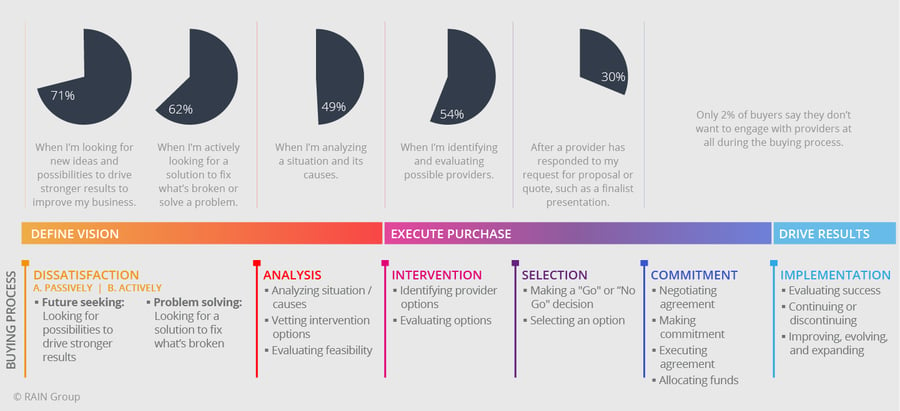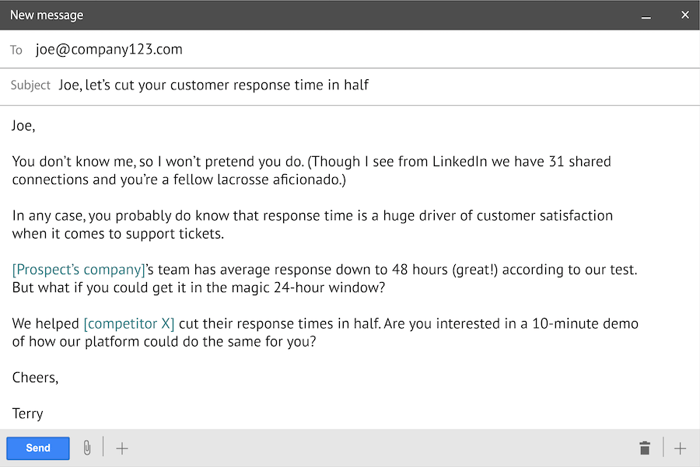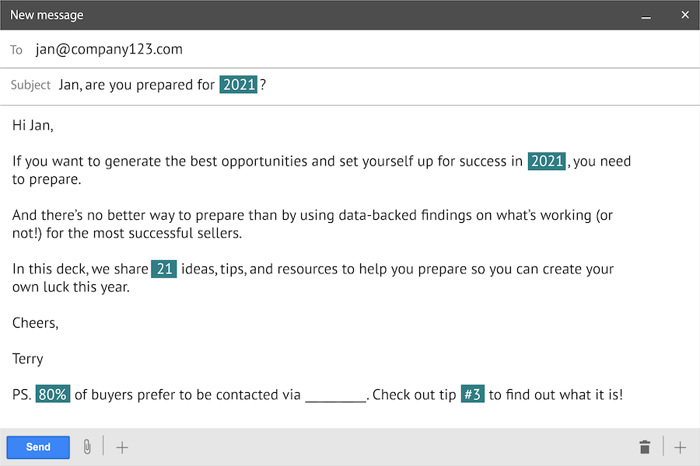TL;DR? Download the PDF and save it for later.
Many sellers assume buyers don't want or need to talk to them early in the buying process.
This simply isn't the case.
In fact, our prospecting research reveals buyers want to hear from sellers early.
When Do Buyers Want to Hear from Sellers in the Buying Process?

That's why email is an essential part of any prospecting plan.
When used in a coordinated attraction campaign, the best prospecting emails are carefully researched, heavily customized, and triggered to hit buyers' inbox at their time of need.
The good news? It works!
- 80% of buyers prefer to be contacted by sellers via email
- 77% of buyers have responded favorably to an email from a new provider in the last 12 months
- 31% of sellers say sending 1-to-1 emails manually after doing research and customizing the message is effective (this ranks in the top 5 most effective prospecting tactics)
Infographic: 30 Must-Know Sales Prospecting Stats
Unfortunately, too many prospecting emails fall victim to common mistakes that kill response rates.
So, what can you do to get more of your buyers to accept meetings via email?
Start with the 13 Golden Rules.
The 13 Golden Rules for the Best Prospecting Emails
|
These 13 tips will help you craft the best prospecting emails that stand out in buyers' inboxes, improve response rates, and ultimately secure more meetings.
13 Prospecting Email Tips
1. Lead with Referrals
84% of B2B buyers start the purchasing process with a referral.1 Seek out referrals from your contacts. If you don't have a mutual contact, create them as you sell to reach the right person. For example, the Executive Assistant to the President can be an excellent resource for internal referrals. He or she might send you to the right person. Once you have the referral, use it in your outreach:
- Jon Snow recommended we get in touch.
- Paola Moreno said you'd be the best person for me to talk to about your distribution challenges.
- George Smith told me he's interested in training for the marketing team.
You can start as early as your subject line. The subject line is your first opportunity to hook the buyer and should be as relevant as possible. Reference a referral or contact, trigger event, ideas you want to share, or questions you have about something going on at the company.
2. Don't be a Robot
You'll lose a prospect's attention the second they suspect you mass emailed them. Make sure you:- Customize: Write something that proves the email wasn't automatically generated. 31% of buyers say sending customized emails is effective, and only 5% say sending bulk email is.
- Have a voice: Emails that use emotion words (e.g., wonderful, hate, delighted, furious) get 10-15% more responses than emails that are neutral.2
- Be action-oriented: Use an active voice ("reduce downtime by 20%") instead of a passive voice ("downtime can be reduced by 20%").
- Be a human: Share personal details. Inject humor. Avoid phrasing that looks cookie-cutter or copy and pasted from a template.
- Avoid attachments, colors, typos, and templates: Templates make it look like the email is coming from your corporate marketing department. Colorful text looks gimmicky, typos are unprofessional, and attachments are more likely to get caught in a spam filter. If you want buyers to take you seriously, your email must look and act the part.
When you draft your introduction email, use the language you would use if you were sending it to an internal colleague. You'll naturally leave out marketing jargon and sales buzz words that reduce trust and turn buyers off. Remember, you are just a person sending another person an email. Write like it.
Here's an example:

3. Be Buyer Centric
In addition to customization, focus on buyer impact over your features and having a compelling value proposition. In your writing, lead with "you" instead of "I," and ask yourself, "Does this email focus on my prospect within the first 3 seconds?"
Here's how:
| ✅ Say This | ❎ Not This |
| Your post on [subject] got me thinking... | I've been thinking... |
| Your question on [LinkedIn Group]... | I'm also a member of [LinkedIn Group]... |
| VPs of Marketing often find that meeting and exceeding inbound lead targets is a huge challenge. Several VPs have told me that... | I've worked with multiple people in your position... |
In my experience, most emails heavily focus on the seller; words describing the seller will outnumber the words about the buyer 6 to 1.
Buyers don't care about you, your company, your products or your services. They care about how you can help them achieve their goals.
Not sure where to start? A little research goes a long way.
Spend a few minutes learning about the prospect before reaching out. You can unearth a wealth of information from simply visiting their LinkedIn profile and Googling the company.
LinkedIn will tell you if you have any contacts in common, what school they went to, what groups they are a part of, what causes are important to them, etc. It's an instant way to see if you are connected (if so, you can ask for an introduction or referral), and to find out if you share any common interests or history.
Perform a quick search on the company and you'll know where they've been featured or quoted. You can even scan their annual report if they're a public company, and read up on recent news on their website.
4. Keep It Short
55% of emails are read on mobile devices.3 Long emails with big blocks of text get deleted immediately.
Give your email a chance for success by keeping it short and sweet, and by cutting fluff and generic phrases.
A good rule of thumb is to keep emails between 50-125 words. Want to take it to the next level? Draft your email on your phone to have a realistic idea of how prospects will read it.
5. Keep It Simple
A third-grade reading level gives a 35% increase in response rate over emails written at a college reading level.4 Use simple words, short sentences, and lots of paragraph breaks.
Need some help? Run your email through Readable to check grade-reading level.
| ✅ Say This | ❎ Not This |
|
You can post to 100+ job boards with one click and view all your best candidates in one place. We make it easy for you to screen and rate them so you can make the right hiring decisions—fast! |
Our platform features an innovative process for listing new openings across job boards and tagging, searching, and organizing job applications and resumes by utilizing cloud computing and decentralized information management. Candidates can be prioritized based on custom criteria and integrated seamlessly with your internal enterprise resource planning, which is a huge benefit to your business. |
6. Use Bullets
People look at lists with bullets more often than those without (70% vs. 55%).5 Bullets draw the eye and capture attention. Put your most important points at the top and bottom of the bulleted list.
| ✅ Say This | ❎ Not This |
|
Small business owners see their top challenges as:
|
Small business owners see their top challenges as managing employee healthcare, dealing with government regulations, and diversifying their client base. |
7. Use the Rule of 3
Give people 3 bullets, 3 choices, 3 adjectives describing your impact, etc. Clustering in groups of 3 makes ideas stick.6 More than 3 choices can confuse people, cause them to tune out, and lead to decision paralysis.
| ✅ Say This |
The top 3 areas we help with are:
|
| Does 11am, 1:30pm, or 4pm work for you? |
| You must also uncover buyer wants, desires, and aspirations to provide maximum value. |
8. Use Numerals
Digits stop and fixate eyes when people scan text. Instead of writing out numbers, use numerals (e.g., seventy-five percent becomes 75%).7

9. Ask Questions
Emails that ask 1-3 questions are 50% more likely to get a response.8
| ✅ Say This | ❎ Not This |
| Is 9:30am or 1:30pm a better time to speak? | Let me know if any of those times work for you. |
| Do you think the results on [research topic] will change your approach to [challenge]? Have you tried any of these strategies in the past? | Look forward to hearing your thoughts on the research. |
| Are you currently working on improving [related business value]? | Out platform can help you improve [related business venture]. |
10. Give Them a Choice
Give recipients an out. Remind them it's ultimately their choice whether they respond or not. This compliance-gaining technique doubles the chance someone will say yes.
For example:
- If you'd rather not, I understand. I appreciate you reading this far.
- Are you able to take this 5-minute survey? Completely up to you, but it would be really valuable for us, and we'll share the results with you soon.
- Your feedback on this research would be extremely helpful, but you're free to just share it with your team.
11. Say Their Name
People's eyes are automatically drawn to their names in print. Put the recipient's name in the subject line or use the recipient's name more than once in the body. Emails with personalized subject lines are 26% more likely to be opened.9
Don't forget to double check for nicknames (LinkedIn can help). Is it Michael or Mike? Margaret or Maggie? Use their preferred name. Don't use Mr. or Mrs.

12. CC Stakeholders
Don't put additional recipients in the "To:" field; put them in the "CC:" field. CC-ing stakeholders improves both open and reply rates by as much as 12%.10 Get in the habit of asking prospects, "Is there anyone else I should copy on the email?"
13. Clarify Your CTA
Make sure what you're asking for (your call-to-action) is crystal clear. Don't ask prospects to let you know what they thought of the video you linked to and to find a time to discuss your latest research and to schedule a demo and to introduce you to their colleague in IT.
It pays to be specific. When you ask for a meeting, propose a date and time. Even once you've established contact with a lead, always include a next step in your emails to them.
Keep it to one ask per email.
Share these email prospecting tips!
View the PDF on SlideShare or download here.
Subtle changes make all the difference in your emails. The best prospecting emails are researched, customized, and part of a well-designed attraction campaign. Give your prospecting emails a makeover with the suggestions listed above to start seeing dramatic differences in buyer response rates and increases in your sales results.





